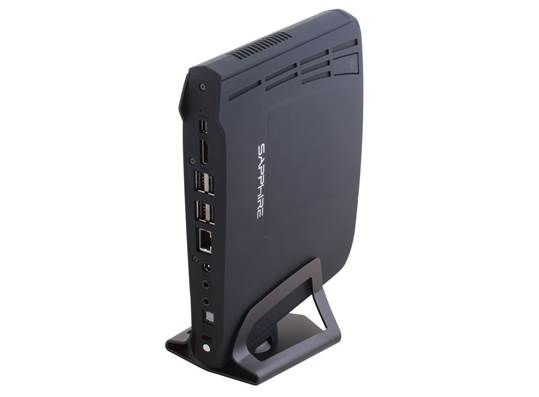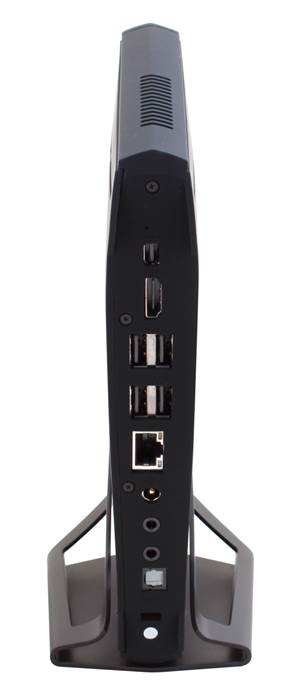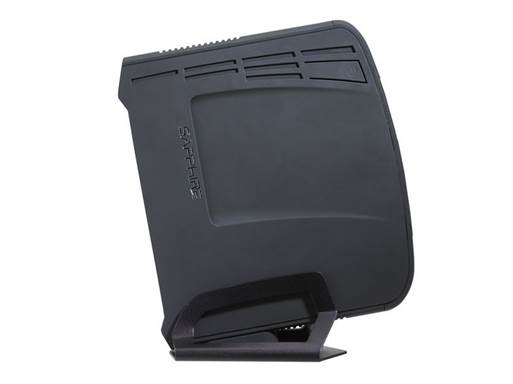Sapphire packs an APU into this tiny
PC, but is this enough for it to punch above its weight?
Sand motherboards, but it's also spent the
last few years ploughing its own furrow when it comes to small form factor PCs.
Its first efforts were built around Intel's underpowered Atom CPUs, but it
hopes that its latest system - the Edge VS8 will have more success with an AMD
APU inside.
The APU in question comes from AMD's latest
Trinity range but, unfortunately, it isn't one of the desktop chips that so
effectively takes on Intel's Core i3 processors with their great GPUs. Instead,
this 24mm-wide machine is so small that Sapphire has had to use a mobile,
low-power chip - the A8-4555M.

Sapphire
Edge VS8
This chip features two Pile driver modules,
and therefore can address four concurrent threads, but it's clocked to just
1.6GHz- much slower than the3.8GHz speed of AM D's top Trinity desktop chip.
This helps to bring down the APU's TDP to 17W, though, compared to the 35W of
other Trinity mobile parts, let alone the 65Wand 100WTDPs of desktop APUs. On
the downside, however, this low-power chip can only cope with controlling
1,333MHz DDR3 RAM, pushing quicker 1,600MHzmemory out of the equation.
The main attraction of an APU, of course,
is its GPU, and the Radeon HD 7600G included in the A8-4555M shares the same
architecture as the GPUs in desktop Trinity parts, so it's based on the same
GPU in full-fat H D 6900-series graphics cards. Here, though, mobile
compromises make another appearance. The most powerful graphics cores inside
desktop Trinity APUs run at 800MHz, but the HD 7600D on offer here is
restricted to 320MHz, with a Turbo Core maximum of 424MHz even slower than the 496
MHz top mobile chip.
It's no surprise that Sapphire has had to
choose a low-power mobile chip for its latest mini-PC though. The Edge VS8 is just
24mm wide and, at 185mm tall, it's several times smaller than most of the
systems we see in the Custom PC lab. It isn't able to lie on its side either;
the odd shape of the chassis means that it has to be screwed into a stand,
where it's held vertically at an odd angle.
It's a good-looking system, despite its
small size. It's constructed from matt-black plastic throughout, with Sapphire
logos on each side and thin white lights illuminating the angled front. Acurved
power button sits towards the top of one side, and the port selection is
reasonably generous. The front houses two USB 3 ports and an SD card reader,
and the rear offers four USB 2 ports, HDMI and Mini Display Port outputs, plus
an optical S/PDIF connector.

It's
a good-looking system, despite its small size.
It's easy to open the VS8 too - you just
remove four screws to slide off the side, but there's no room for extra
components. The two RAM slots are occupied, and the single 2.5in hard disk bay
is taken too. That said, both these components can easily be replaced.
This tiny system won't break the bank
either, although the $604 you'll have to pay to get your hands on the VS8
doesn't include an OS. Unless you're happy to stick with Linux, that means
around $106 on top for an OEM copy of Windows, and the added expense brings the
VS8 into line with more competition. Intel's bare bones NUC system, for example,
costs a similar amount once components are added, and even Apple's entry-level
Mac Mini costs just $754 and includes a Core i5 processor

AMD's
APUs have traditionally offered a keen balance between application and gaming
performance, but this mobile chip isn't as effective
Performance
AMD's APUs have traditionally offered a
keen balance between application and gaming performance, but this mobile chip
isn't as effective. Its score of 483 points in our image editing benchmark lags
a long way MINI PC
Behind machines several years old, and is a
long way off the performance from the Core i3 inside Intel's NUC. The VS8
didn't excel in any other tests either, scoring 890 in our video encoding
benchmark, 547in the multi-tasking test and just 661 points overall.
TheVS8 was similarly sluggish in our gaming
tests. It barely functioned in our standard Ultra quality Battlefield 3 test,
and the situation didn't improve at Low quality, with a very poor minimum frame
rate of 5fps. We loaded our Left 4 Dead 2 benchmark to see if it could cope
with a less demanding game, and the news wasn't much better: the game had a
minimum of 17fpsat Low quality when running at 1,920 x 1,080 - the standard
resolution of TVs available today.
Other games tests reinforced the Sapphire's
low-end abilities. We had to run DiRT3 at 1,600x900 at its Low quality settings
before recording an unplayable minimum of 20fps, for example.
We weren't able to overclock the mobile
core to improve these results either. While Sapphire has included a UEFI BIOS
with the VS8, no tweaking options are included. The VS8 also pumped out a
surprising amount of fan noise when playing games.
The single 40mm fan inside will be easily drowned
out by speakers, but it's still more noise than we expect from small form factor
machines.
The VS8's 500GB Western Digital Blue hard
drive didn't impress either, with sequential read and write speeds in AS-SSD of
93.7M B/sec and 92.5MB/sec respectively around a quarter of the pace of current
SSDs. The sluggish hard disk combined with the weak APU made for an
underwhelming Windows 8 experience too: while the Start screen zipped by
without complaint, boot times were long, and software took a while to open as
well.

Inside
The VS8's 500GB Western Digital Blue
At least the VS8 was frugal in our power
tests. Its respective idle and peak power draws of 15Wand34W are among the
lowest we've seen. Comparatively, the Intel NUC returned idle and peak power
levels of 8W and 20W, which are better results, but both area boon for anyone
keeping an eye on their electricity bill.
Conclusion
It might have a small case and low power
consumption, but Sapphire's EdgeVS8 is just too underpowered. It isn't as quick
as the Core i3-powered NUC in Windows apps, it's underpowered in games, despite
having the APU, and other systems offer better value for money. Intel's NUC is
cheaper even when components are factored in, and even Apple's cheapest Mac
Mini offers better value. We like the idea of APU-based mini PCs, but the
mobile chip used in the VS8 isn't a patch on AMD's desktop parts.
|
Info
§ Price:
$604
§ Manufacturer:
www.sapphiretech.com
In Detail
§ CPU:
1.6GHz AMDA8-4555M
§ Memory:
4GB(2x2GB SODIMM) 1,333MHz DDR3
§ Graphics:
AMD Radeon HD 7600G
§ Sound:
Realtek HD Audio
§ Hard
disk: 500GBWestern Digital Blue WD5000BPVT
§ Optical
drive: Not supplied Case Sapphire small form factor
§ Cooling:
CPU: 1 x Sapphire 40mm
§ PSU:
Sapphire external PSU
§ Ports:
Front:2xUSB,SD card reader; rear: 4x USB 2, 1 xHDMI, 1 x Mini Display Port,
1xLAN, 1 x opticalS/PDIF,2xaudio
§ Operating
system: Not supplied
|